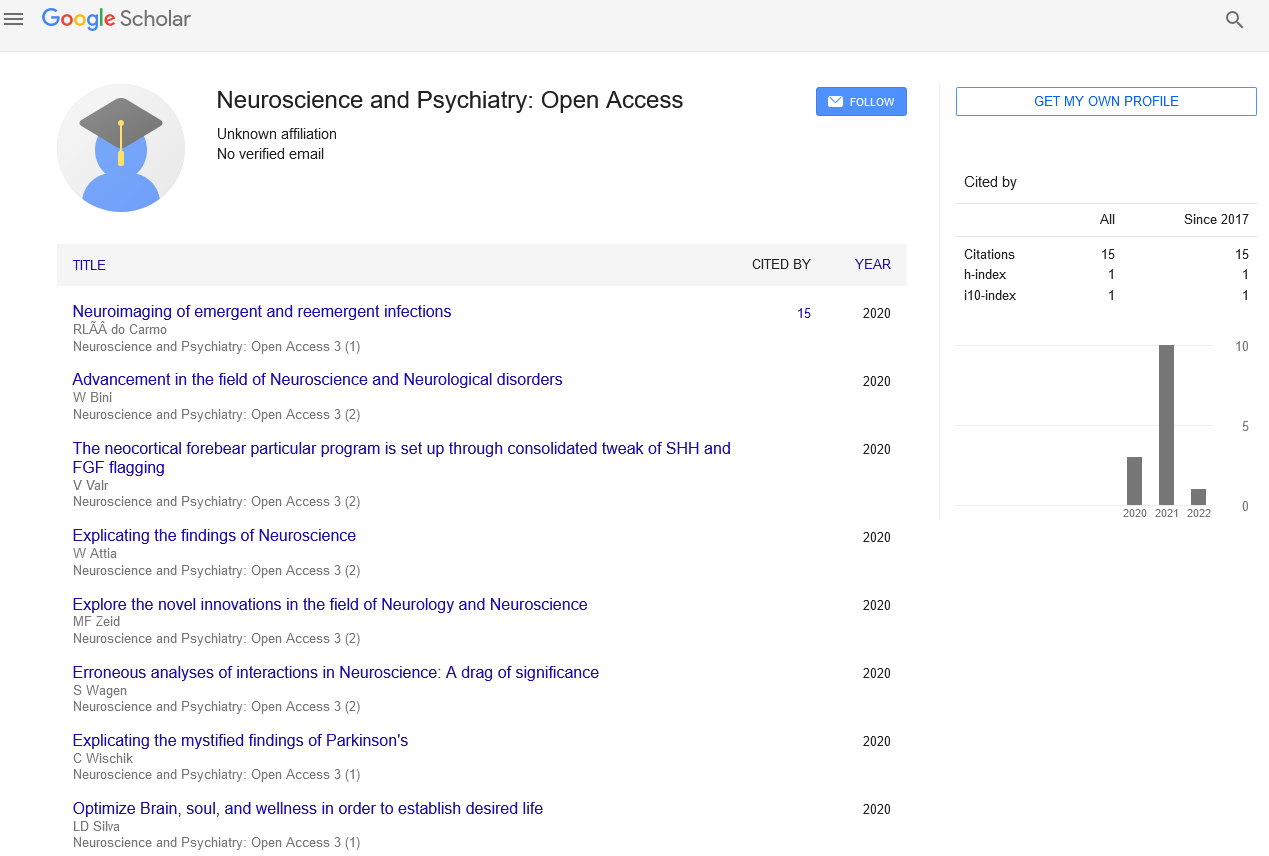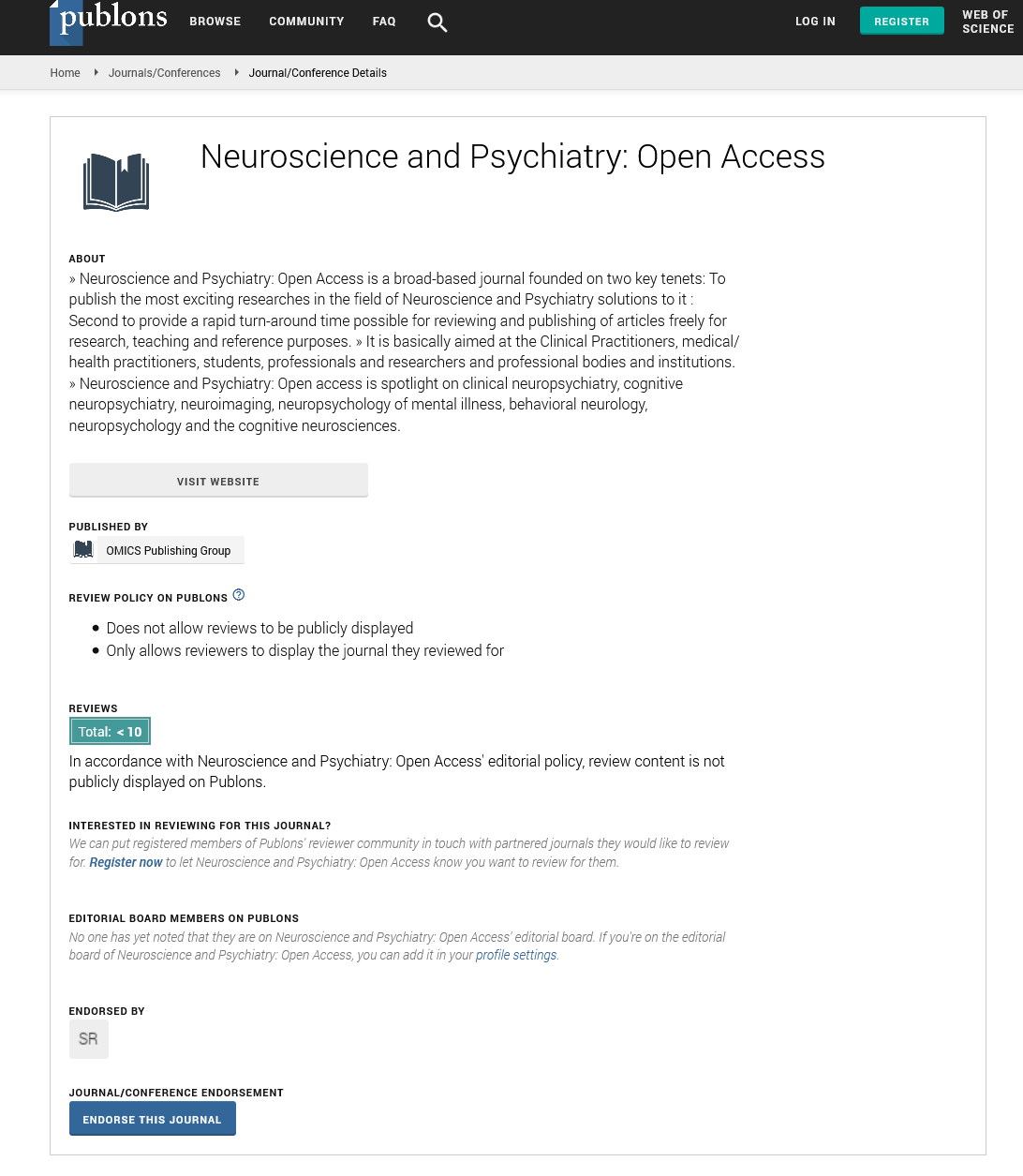Perspective - Neuroscience and Psychiatry: Open Access (2024) Volume 7, Issue 3
Exploring the Intricacies of Molecular Neuroscience: Unraveling the Mysteries of the Brain
- Corresponding Author:
- Alexander Shackman
Department of Psychological and Brain Sciences, University of California, Santa Barbara, USA
E-mail: Shack56@umd.edu
Received: 06-04-2024, Manuscript No. NPOA-24-128832; Editor assigned: 09-04-2024, PreQC No. NPOA-24-128832 (PQ); Reviewed: 23-04-2024, QC No. NPOA-24-128832; Revised: 03-05-2024, Manuscript No. NPOA-24-128832 (R); Published: 10-05-2024, DOI: 10.47532/npoa.2024.7(3).211-213
Introduction
Molecular neuroscience stands at the forefront of scientific inquiry into the complex workings of the brain, seeking to unravel the molecular mechanisms underlying neural function, development, and disease. From the intricate signaling pathways orchestrating synaptic transmission to the genetic factors shaping brain development and plasticity, molecular neuroscience offers profound insights into the fundamental principles governing brain structure and function. In this article, we embark on a journey into the realm of molecular neuroscience, exploring its foundational concepts, cutting-edge research techniques, and transformative implications for understanding the brain in health and disease.
Description
Foundations of molecular neuroscience
At its core, molecular neuroscience seeks to elucidate the molecular events occurring within neurons and glial cells that underlie brain function and dysfunction. Key areas of inquiry include:
• Neurotransmission: Neurotransmitters, the chemical messengers that facilitate
communication between neurons, lie at the heart of synaptic transmission the process by
which signals are transmitted across neuronal synapses. Molecular neuroscience endeavors
to unravel the mechanisms governing neurotransmitter synthesis, release, receptor binding,
and synaptic plasticity, shedding light on the dynamic processes underlying neuronal
communication.
• Ion channels and membrane excitability: Ion channels, specialized proteins embedded in
neuronal membranes, play a critical role in regulating the flow of ions across cell membranes
and modulating neuronal excitability. Molecular neuroscience investigates the structure,
function, and regulation of ion channels, including voltage gated channels, ligand-gated
channels, and neurotransmitter transporters, providing insights into the mechanisms
governing neuronal firing and action potential generation.
• Neuronal signaling pathways: Intracellular signaling pathways transduce extracellular
signals into cellular responses, regulating diverse aspects of neuronal function, including
gene expression, synaptic plasticity, and cell survival. Molecular neuroscience delves into the
intricate network of signaling molecules, receptors, and second messengers that orchestrate
neuronal signaling, unraveling the mechanisms underlying neuronal development, synaptic
transmission, and neuronal plasticity.
• Neurodevelopment and synaptic plasticity: The formation, refinement, and remodeling of
neuronal circuits during development and in response to experience are orchestrated by
a myriad of molecular cues and signaling pathways. Molecular neuroscience investigates
the genetic and molecular mechanisms governing neurodevelopment, synaptogenesis, and
synaptic plasticity, shedding light on the processes underlying learning and memory, as well
as neurological disorders characterized by synaptic dysfunction.
Cutting-edge techniques in molecular neuroscience
Advances in molecular biology, genetics, imaging, and electrophysiology have revolutionized the field of molecular neuroscience, enabling researchers to probe the intricacies of the brain with unprecedented precision and resolution. Key techniques include:
• Genomic and transcriptomic analysis: High-throughput sequencing technologies
have facilitated the comprehensive
analysis of the brain’s genetic blueprint,
allowing researchers to identify genes and
regulatory elements implicated in neuronal
development, function, and disease.
Transcriptomic approaches, such as RNA
sequencing, provide insights into gene
expression patterns across different brain
regions, cell types, and developmental stages,
elucidating the molecular underpinnings of
neuronal diversity and specialization.
• Optogenetics and chemogenetics: Optogenetics and chemogenetics harness
the power of genetically encoded tools to
manipulate neuronal activity with exquisite
spatiotemporal precision. By expressing
light-sensitive or chemically sensitive
proteins in specific populations of neurons,
researchers can selectively activate or inhibit
neuronal activity in living organisms,
enabling causal interrogation of neural
circuits and behavior and providing insights
into the neural basis of complex behaviors
and neurological disorders.
• Single-cell analysis: Advances in single-cell
transcriptomics and imaging techniques
have enabled researchers to dissect the
heterogeneity of neuronal populations at
unprecedented resolution. By profiling
the transcriptomes of individual neurons,
researchers can identify molecularly distinct
cell types, characterize developmental
trajectories, and uncover cell type-specific
gene expression patterns underlying
neuronal function and dysfunction.
• High-resolution imaging: Cutting-edge
imaging techniques, such as two-photon
microscopy, super-resolution microscopy,
and electron microscopy, enable researchers
to visualize the structure and function of
neurons and synapses with unprecedented
detail and resolution. These techniques
allow for the visualization of synaptic
dynamics, neuronal morphology, and
subcellular structures in living organisms
and provide insights into the spatial
organization of neural circuits and the
molecular mechanisms underlying synaptic
transmission and plasticity.
Transformative implications for brain health and disease
The insights gleaned from molecular neuroscience have transformative implications for understanding the brain in health and disease, paving the way for the development of novel diagnostic tools, therapeutic interventions, and personalized treatments for neurological and psychiatric disorders.
• Precision medicine approaches: Precision
medicine approaches leverage molecular
insights to tailor diagnostic and therapeutic
strategies to the individual characteristics
of each patient. By integrating genomic,
transcriptomic, and other molecular data,
researchers can identify molecular subtypes
of neurological and psychiatric disorders,
predict disease progression, and stratify
patients based on their molecular profiles.
Precision medicine approaches enable
personalized treatment strategies targeting
the underlying molecular mechanisms
driving disease pathogenesis, maximizing
therapeutic efficacy and minimizing adverse
effects.
• Targeted therapies: The elucidation
of molecular pathways implicated in
neurological and psychiatric disorders has
fueled the development of targeted therapies
aimed at modulating specific molecular
targets or pathways. From small-molecule
inhibitors and monoclonal antibodies to
gene therapy and RNA-based therapeutics,
a diverse array of targeted therapeutic
approaches is under investigation for
the treatment of neurodegenerative
diseases, neuropsychiatric disorders, and
developmental disorders. These targeted
therapies offer the potential for disease-modifying treatments that address the
underlying molecular abnormalities driving
disease progression, offering hope for
improved outcomes and quality of life for
affected individuals.
• Biomarker discovery: Molecular neuroscience
has facilitated the discovery of novel
biomarkers for neurological and psychiatric
disorders, enabling early diagnosis, prognostic assessment, and monitoring of treatment
response. Biomarkers derived from genomic,
transcriptomic, proteomic, and neuroimaging
data provide insights into disease pathogenesis,
identify molecular targets for therapeutic
intervention, and facilitate patient stratification
in clinical trials. Biomarker-based diagnostic
tests and imaging biomarkers offer the potential
for non-invasive, objective assessments of
disease status and treatment efficacy, guiding
clinical decision-making and improving
patient outcomes.
Conclusion
Molecular neuroscience represents a powerful approach to unraveling the mysteries of the brain, offering profound insights into the molecular mechanisms underlying neural function, development, and disease. By leveraging cutting-edge techniques and interdisciplinary approaches, researchers continue to push the boundaries of knowledge in the field, uncovering the molecular underpinnings of brain health and dysfunction. The transformative implications of molecular neuroscience extend far beyond the laboratory, offering hope for improved diagnostics, targeted therapies, and personalized treatments for neurological and psychiatric disorders, ultimately enhancing the lives of individuals affected by these devastating conditions.


